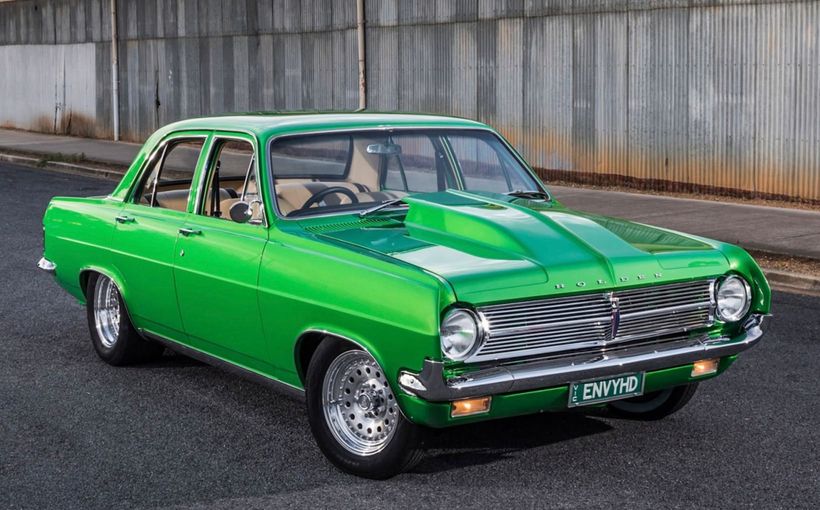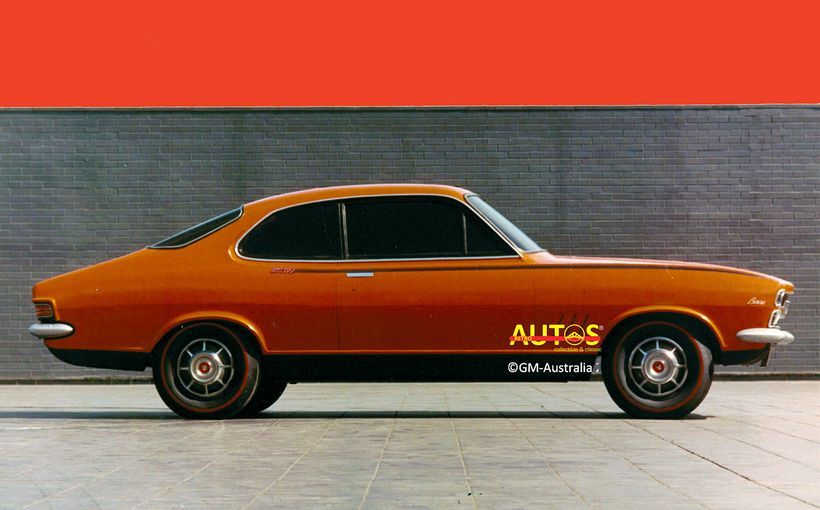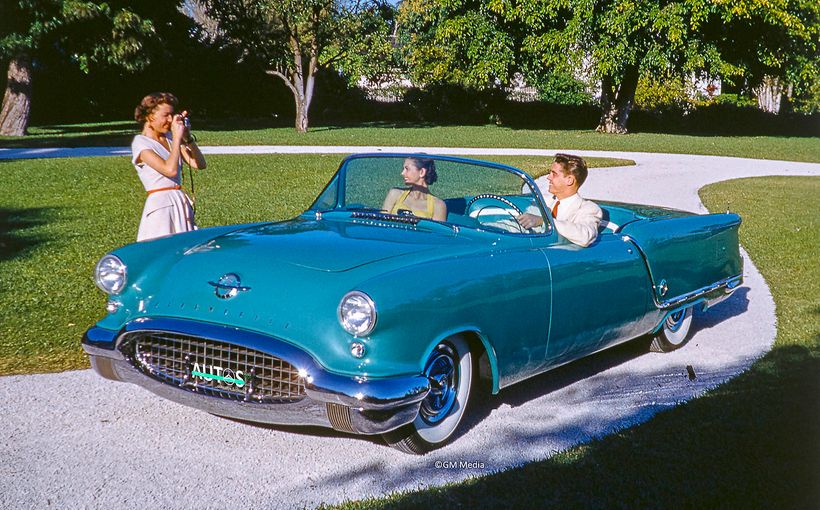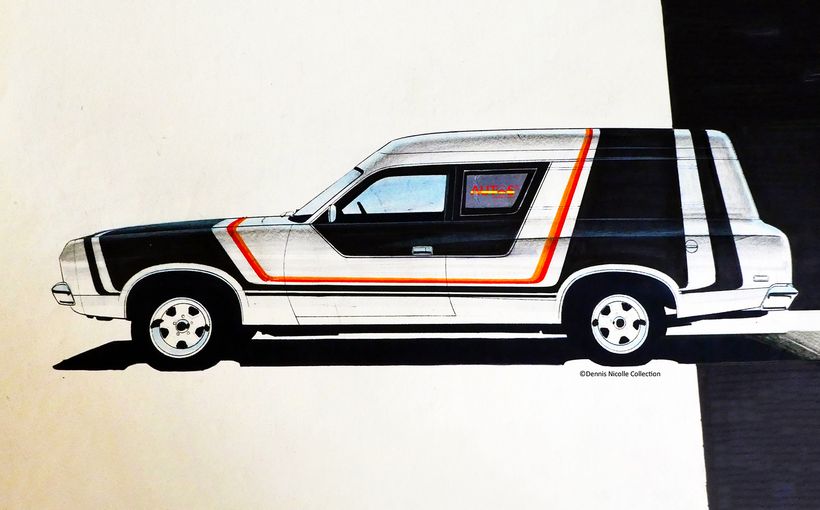WB Statesman - Massive Grace: Exclusive Prototype Photos & Design Story

“Everyone thinks it is based on a Cadillac,” says WB Statesman and Caprice designer, Leo Pruneau, “but it is not.”
“I wanted to reflect the Aston Martin Lagonda in its lines,” he says. Flat rear flanks, a wide stand-up grille and an overall theme of crisply folded edges define the shape of both cars.
The 1980-85 WB Statesman/Caprice would be one of Leo’s last Holdens and he was determined that it would be distinctive.


How the WB Statesman/Caprice went from design to driveway provides a fascinating insight into the decision making processes at Holden back in the mid-1970s. Set against a global economic downturn, local political instability, the uncertainties caused by the first Middle East oil embargo and rapidly rising fuel prices, it was not an ideal time to be planning a large V8 locally built luxury automobile for a small market.
The shape of the WB Statesman/Caprice had formed in Leo‘s mind after he returned to Australia from the USA in May 1975 to take over as Holden’s Design Director from Joe Schemansky, who was retiring.
Leo had been in the USA after an earlier stint at Holden as Assistant Design Director, between October 1969 and late 1972. Whilst in America he’d worked in the Advanced styling studios and directly for Bill Michell, GM’s global design boss, in his special projects’ studio.
When Leo walked back into Holden’s high security design centre, he found a company which was as undecided about its future range of models as it had been when he’d left three years earlier.
Back in 1971, when the HQ was released, Holden’s forward plans called for the HQ series to be facelifted into the HV and launched in 1973.
In volume 3 of my Design to Driveway book series, Holden’s chief designer Peter Nankervis explained that work on the HV started “in 1970, long before the HQ was released. Chris Emmerson and I did many sketches. These were an evolution of the HQ’s smooth soft styling.” Leo adds that “I also wanted to visually lift the rear end of the HQ, which I thought looked a little droopy.”


While Peter and Leo were focused on the HV, market research clinics were being conducted for the unreleased HQ, comparing it with the boxier XY Falcon and VG Valiant. The feedback suggested some potential buyers thought the HQ appeared too “soft” and smaller than its competition. This research was supported by some of the initial anecdotal reactions to the HQ when it was first released. Ironically, the HQ was actually longer than the Falcon. It just did not look bigger.
This early feedback made an impact on Holden’s top decision makers and they decided to shift the emphasis of the HV styling to a more angular and visually substantial theme. Holden’s then Managing Director, Max Wilson, had also expressed a liking for a more upright front end. The HV proposal was terminated and a new design program was implemented, coded HJ, with a release date of mid-1974.


In Holden’s long range product plans the successor to the HQ/HJ was to be the WA. It was scheduled for a January 1978 release. Work started on the WA in mid-1973. Leo had already returned to the USA. His replacement as Assistant Design Director was J.R. “Dick” Finegan.
Given the oil supply crisis and poor economic outlook the WA was planned to be smaller than the HQ/HJ. It would be built on a shortened HQ frame with a wheelbase of 108 inches/2734mm for the Kingswood/Premier. The commercials and Statesman/Caprice would have a slightly longer wheelbase. The estimated cost to develop the full range was between $80-$100 million dollars.


As I wrote in my Retroautos story on the WA and VB-VL Commodore (see end of this story for the link), a combination of financial pressures, shrinking market share (thanks to an aggressive Ford and value for money imports), the oil crisis, the Federal Labor government’s unilateral decision to immediately reduce tariff protection by 25% in July 1973 and an innate conservatism within Holden's top management caused the accountants and main decision makers to baulk at the WA’s development costs. They wanted a cheaper solution.
That cheaper solution involved cancelling the WA program and stretching the life of the HQ/HJ into the HX and HZ models. These were to be followed by a major re-style using as many carryover panels as possible to save money.
As author and retired design director of Toyota Australia, Paul Beranger, insightfully wrote in his must-have book Crayon to CAD, Holden’s “business was being driven by bean counters, less interested in product that had customer appeal than concerns over expenditure.”


The restyle was coded WB and would sell as the short wheelbase Kingswood/Premier and long wheelbase commercials and Statesman/Caprice. For the Torana, the plan was to re-shape the LH/LX and call it the VA.
The main problem was that Holden’s decision makers could not make up their minds as to exactly what the WB ought to look like and the accountants continued to demand more cost cutting. This meant retaining as many of the exiting HQ panels as possible.
Then, in early 1975 it all changed again. Holden was directed by GM in Detroit to “consider” using the planned 1977 Opel Rekord/Vauxhall Carlton, the V-car, as a replacement for the VA Torana.
It was around this time that Leo stepped off the jet from Detroit and six months later, in January 1976, Chuck Chapman was appointed as Holden’s new Managing Director.
Chapman had been GM’s chief engineer in Europe and was deeply involved in developing the V-car. He supported it replacing the Torana and the VA program was halted. The WB would sit above the new V-car in the size and pricing hierarchy.
And so, the work on Australianising the V-car into the VB Commodore began, and the ever-changing shape of WB range continued to evolve.
Then came a significant decision. Chapman chose to elevate the V-car as Holden’s mainstream sedan and wagon offering. Later, the WB range was cut back to just the commercial and the Statesman/Caprice models. What was obvious to insiders, was that the WB would be the final version of the HQ platform.
Meanwhile, Dick Finegan left to become design director of GM Brazil and his place was taken by John “Kip” Wasenko.

Kip arrived in Melbourne having been part of the team, which also included Finegan, that had shaped GM’s mid-engine rotary powered Corvette concept car in 1972. Prior to joining Holden he’d been at Opel, working on the V-car. After he left Holden he would design Pontiacs and GM’s new Saturn. He would lead the Cadillac design studio for a decade and turn the Holden Monaro into the 2005 Pontiac GTO Ram Air 6 Concept.

Designing the Statesman and Caprice
Work on the cars began in 1976. An early proposal was to widen the C pillar, flatten the rear fenders and create a horizontal design with wide tail lights. This new rear end design increased the visual width of the car and would survive into production.
The wider C pillar evolved into a six-window design with straight lines. The roof line was lengthened and the angle of the back window became more vertical in order to increase rear headroom.



At the front, the deep and large Cadillac style grille was replaced with the distinctive Lagonda-type grille, which also had Rolls-Royce overtones. It was hand built, too. “When we were designing the grille,” says Leo, “I wanted each of the vertical bars to be hand built into the unit, just like they did at Rolls-Royce. To my surprise the engineers said ‘ok’ and we never told the accountants what we were doing.”
Leo has always maintained that Australians prefer cars with clearly defined edges, rather than those with rounder panels.


A design feature of the HQ which Leo wanted to eliminate were the long “eyebrows” over the top of the wheel arches. The bean counters would not allow money to be spent on new fenders or doors. Leo had to hide the “eyebrows” with a full length thick and wide colour coded rubbing strip.




“That strip had to be especially manufactured,” Leo says. “If you looked at the body-side of one you could see how it was deeply contoured to accommodate and hide the changing shape of the eyebrows.”



Ken Foletta was in charge of the interior. Leo tasked him with developing an ambience that matched the crisp exterior design theme. And he succeeded. The single spoke steering wheel, which was also appeared on the S/LE Commodore, was the only time such a wheel was used within the GM world. “I’m very proud of that,” Leo says. “The single spoke wheel really showed-off all the work Ken had done on the dashboard. A driver could see all the dials and gauges at one glance.”
At one stage during development there was a push to use real wood throughout the interior, but testing confirmed it was not durable in the Australian climate.


Whilst the design of the interior met the exacting expectations of the design team, actually building the interior to the high standards required in a luxury car proved more elusive
“I remember sitting in the back of a Caprice with our chief engineer, Joe Whitesell,” Leo recalls. “We were on our way to the airport and I started to point out all the small problems inside the car. There were panels that were not aligned, upholstery stitching that was not straight, a couple of loose knobs and such like. On an expensive car it was not good enough. Joe said he’d try to see what could be done, but he had no control over the production process. It was a real shame because it is these little things which make a big impression on luxury car buyers. We just could not get it right.”
There was also a plan to market a Statesman wagon. It never went beyond the mock-up stage.


In August 1979 a full-size fibreglass mock-up, complete with opening doors and fitted interior, was air freighted to Detroit. It was featured at the annual GM Directors’ “car show” of new models. Only a selection of GM’s vast line up was showcased for the Directors, so its inclusion speaks volumes about its styling and visual impact. Says Leo: “It was eventually returned to us and I’ve always wondered what happen to it.”
The Statesman and Caprice gained favourable reviews when released in May 1980. That the WB was based on a design that could trace its creation to mid-1968 says a lot about the timelessness of the original HQ shape and the skills of Leo and his team to update it for the 1980s.
And let’s not forget it was also given RTS suspension, which improved the handling to the point of it being able to hold its own alongside more expensive European cars.
I’ve always admired the WB. It has real presence on the road and in the driveway. To me it was the first Statesman which really matched the prestige of Ford’s LTD.
When thinking about how to describe the car I keep going back to two words used by authors David Holls and Michael Lamm in their book, A Century of Automotive Style, to explain their admiration for the shape of the 1965 Chevrolet Impala. It has a “massive grace” they wrote.
Massive Grace—two words which I also believe beautifully summarise the WB Statesman and Caprice.

Home grown and built luxury, long wheelbase cars kept selling during the three decades after the WB was “retired” in 1985. They were aspirational cars, bought by those who valued the Made in Australia label. But, as we know, sales slowed year on year as buyer preferences for European brands and luxury SUVs increased.
From around 2010 onwards the Statesman and Caprice were rarely seen in private hands. Most were lined up outside airports as the limo of choice.
And now they are no more. Their likes will never be designed and built in this country again.
There’s additional information on the WA Holden/VB Commodore in my Retroautos story at this LINK. If you want to know more about the Statesman, Mark Oastler has written a very comprehensive history of all models in the Super Models section. Here’s the LINK.
Thanks to John Field and Richard Ferlazzo for providing access to Holden’s design studio archives for this story.
Retroautos is written and published with passion and pride by David Burrell.









